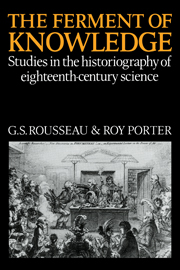Book contents
- Frontmatter
- Contents
- Contributors
- Acknowledgements
- Abbreviations
- Introduction
- PART I PHILOSOPHY AND IDEAS
- PART II LIFE AND ITS ENVIRONMENT
- PART III THE PHYSICAL WORLD
- 8 Mathematics and rational mechanics
- 9 Experimental natural philosophy
- 10 Chemistry and the chemical revolution
- 11 Mathematical cosmography
- 12 Science, technology and industry
- Index
11 - Mathematical cosmography
Published online by Cambridge University Press: 03 May 2010
- Frontmatter
- Contents
- Contributors
- Acknowledgements
- Abbreviations
- Introduction
- PART I PHILOSOPHY AND IDEAS
- PART II LIFE AND ITS ENVIRONMENT
- PART III THE PHYSICAL WORLD
- 8 Mathematics and rational mechanics
- 9 Experimental natural philosophy
- 10 Chemistry and the chemical revolution
- 11 Mathematical cosmography
- 12 Science, technology and industry
- Index
Summary
Introduction
Cosmography, in the context of this portrayal of a historically neglected area of eighteenth-century science, is another name for the ‘Idée Générate de la Géographie’ drawn up in 1752 by Philippe Buache, son-in-law of the famous French cartographer Guillaume De L'Isle and his successor as first geographer to Louis XV. This scheme was then presented to the Paris Academy of Sciences in the form of three charts containing detailed classifications of historical, physical, and mathematical geography respectively; these were duly approved nine years later, and published in 1762. Significantly, the third chart ‘Géographie Mathématique ou Astronomique’ is identical, down to the last detail, with another entitled ‘Mathematische Astronomie’ in Johann Gabriel Doppelmaier's Atlas coelestis (Nuremberg, 1752). The two titles reflect what may at first appear to be ambiguity in the conceptions of geography and astronomy, but arise from the fact that ‘astronomy’ was then regarded as possessing a terrestrial as well as a celestial component. The eighteenth-century meaning may, however, be captured by substituting the word ‘cosmography’ to encompass both components of that broader definition. The major sub-divisions of this classificatory system may therefore be represented as shown in Fig. 1.
According to Doppelmaier, Buache, and the Paris academicians, the category ‘earth’ includes: the knowledge of the shape of our planet; its climate in the torrid, temperate, and polar regions; the specification of great circles such as the equator, horizon, and meridian, and small circles such as the tropics, arctic circles, and latitude circles generally.
- Type
- Chapter
- Information
- The Ferment of KnowledgeStudies in the Historiography of Eighteenth-Century Science, pp. 417 - 448Publisher: Cambridge University PressPrint publication year: 1980
- 7
- Cited by



